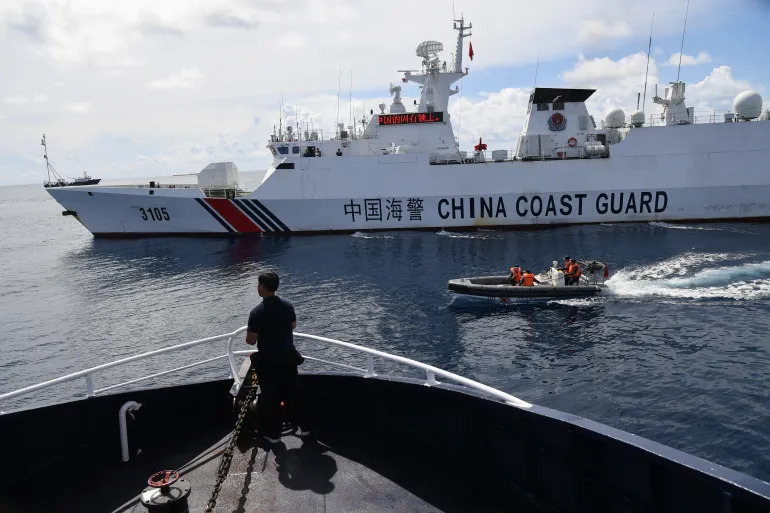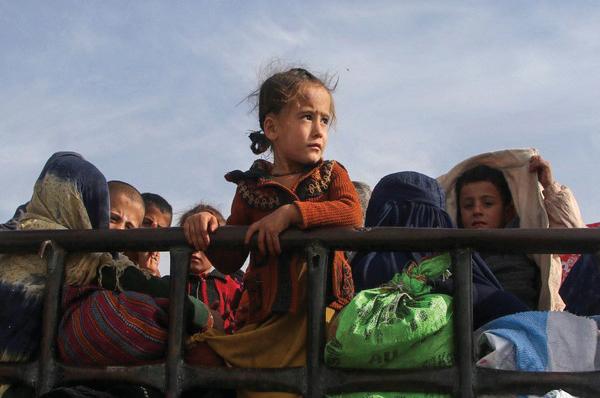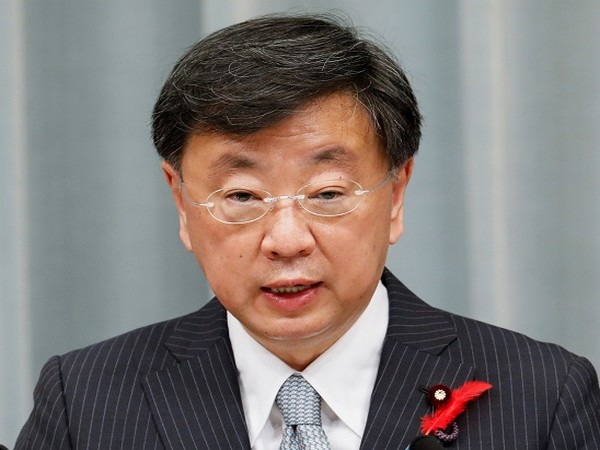In a clear display of a hardened stance towards the Philippines, Chairman Xi Jinping has evidently directed agencies such as the China Coast Guard (CCG), under his direct command, to exhibit increased assertiveness in the South China Sea. Second Thomas Shoal, a submerged reef positioned 194 kilometers west of the Philippine island of Palawan, has emerged as a significant hotspot in the region. This reef is notable for housing the Philippine Navy’s aging landing ship, BRP Sierra Madre, grounded in 1999 to reinforce Manila’s territorial assertion. Notably, Second Thomas Shoal is merely 32 kilometers away from China’s military base on Mischief Reef.
China has been harassing Philippine resupply missions to the Sierra Madre’s garrison of Philippine marines for more than a decade, but last year it intensified these efforts to an alarming scale. For example, a swarm of 38 Chinese vessels maneuvered recklessly and employed water cannon during a resupply mission on 10 November, 2023. Then, on 10 December, 2023, the CCG deliberately rammed a Philippine vessel. In further resupply missions this year, the CCG has routinely employed water cannon against Philippine civilian resupply vessels, resulting in damage to boats and injuries to crew.
Concerning the most recent incident in late March, Philippine Coast Guard (PCG) spokesman Commodore Jay Tarriela complained, “Their barbaric act of using water cannon to attack the resupply boat that endangered the lives of the Filipino troops is a clear manifestation of their blatant disregard of international law.”
The CCG and People’s Armed Forces Maritime Militia (PAFMM) are the culpable parties in these acts of gray-zone coercion, but the People’s Liberation Army (PLA) plays a supporting role. For instance, a PLA Z-8 helicopter was recently filmed hovering low over a team of Philippine scientists on Sandy Cay, just 3km from Philippine-occupied Thitu Island, in a deliberate attempt to force them off the sandbar. Before they withdrew, the scientists confirmed that the fish and coral were in a “very poor state” amidst a manmade pile of rubble.
Chinese dredging and land reclamation have given that country an extra 1,300 hectares of land in the Spratly Islands. The Philippines occupies eight features in the Spratly Island chain, the largest of which is Thitu Island. PAFMM vessels have swarmed other shoals in the Philippine exclusive economic zone (EEZ), with 135 boats detected at Whitsun Reef last December, for example. Beijing’s sea control tactics feature swarming to achieve temporary local control, plus mission-kill actions like water cannon, ramming, and now the use of helicopters.
Unfortunately, the Philippines does not have the necessary fleet nor size of ships to effectively counter such tactics, plus it is reticent to employ more capable Philippine Navy assets in case it amplifies tensions.
Why is China doing this? It reflects Beijing’s exceptionalism stance, whereby it believes international law does not apply to it. The most obvious example is the Permanent Court of Arbitration’s ruling in 2016 that Beijing’s South China Sea territorial claims have no legal basis whatsoever. China is prosecuting aggressive expansionist maritime territorial claims, and it is adamant that it wants to control everything within its illegal and ambiguous Nine-Dash Line claim.
Sino-Philippine ties were relatively good under Rodrigo Duterte’s administration, primarily because he complied with Chinese demands. As long as the Philippine government remained subservient to Beijing, China held its forces in check. However, as soon as Manila stood up for its rights, China took its gloves off.
Today, China persistently refers to an “agreement” whereby the Philippines promised to remove Sierra Madre from Second Thomas Shoal. For example, China maintains that Manila “has gone back on its own words, refused to fulfill its commitment, repeatedly broken its promise made to China, and severely violated Article 5 of the Declaration on the Conduct of Parties in the South China Sea.”.
The Philippines denies that any such agreement exists. Duterte possibly made such a commitment, but he certainly did not put it on paper because it would have been deeply unpopular at home. Furthermore, China has failed to provide any evidence of such an agreement.
President Ferdinand Marcos Jr. has been more proactive in defending Philippine sovereignty than Duterte ever was, and he has scotched any promises his predecessor may have made. In January 2023, Marcos met Xi, and they agreed to resolve differences peacefully. However, that very same month, Filipino fishermen inside the Philippine EEZ were chased away by the CCG, and the following month, the CCG aimed a laser at a PCG vessel.
The CCG is supposed to enforce maritime laws and enhance maritime safety. Instead, force is a blunt weapon in the government’s arsenal of nationalistic territory-grabbing and coercion. In the face of China’s blatant aggression, Manila has changed tactics. As PCG spokesman Tarriela pointed out, “The Philippine government has chosen to expose China’s aggression and unlawful actions in the West Philippine Sea. It is important to clarify that the escalating tensions in the West Philippine Sea are not caused by the United States but by the PRC. While the US is an ally of the Philippines, it is not the root cause of the tensions. The Chinese government should avoid confusion and learn to recognize that if they were only sincere in their words and chose not to bully other countries in the South China Sea, tensions would not be as high. Unless, of course, what China means by lowering tension is being submissive or not reacting to their bullying and aggressive actions!”
From 2016 to June 2022, Manila filed 388 diplomatic protests against China concerning the latter’s actions in the South China Sea. The Marcos administration had filed an extra 147 protests as of late March 2024. Philippine-US ties rebounded after Duterte, who is staunchly anti-American, departed. However, the two Mutual Defense Treaty partners need to decide what an “armed confrontation” entails and how they will respond to Chinese provocation. The American military is stretched taut by current commitments and conflicts in places like Ukraine and the Middle East, though its P-8A aircraft have provided overwatch during Second Thomas Shoal resupply missions.
Manila’s induction of BrahMos coastal missile batteries and the eventual acquisition of multirole fighters will give the Philippines more heft, but such assets are wholly inappropriate against China’s gray-zone tactics. This is precisely Beijing’s purpose. It operates just under the threshold that it believes equates to armed conflict, but at the same time, it continues to push the boundaries. The PCG and Philippine Navy need a stronger presence to deter an emboldened China, though without unnecessarily stoking tensions.
China will not mind pressuring the Philippines into an unfortunate incident, as indicated by the following type of comment: Hu Xijin, a former editor of the Chinese Global Times tabloid, tweeted, “As a media professional, I strongly advocate that China should not fire the first shot in various frictions. This should be upheld as a principle of goodwill for peace in the South China Sea. But the Philippines should listen carefully. Once the Philippines fires the first shot, I fully support China’s PLA in making Philippine ships riddled with bullets. I believe most Chinese people will support it by then.” Collin Koh, Senior Fellow at the Institute of Defense and Strategic Studies of the S. Rajaratnam School of International in Singapore, countered, “[If the] PRC fires the first shot, it triggers the Mutual Defense Treaty. If the Philippines fires the first shot in defense of legitimate maritime interests and the PRC hits back, it also triggers the Mutual Defense Treaty. You may quibble whether the Americans will commit, but any prudent PRC defense planner won’t take these calculations in a cavalier manner.”
It is clear that a South China Sea Code of Conduct between China and other claimants, which Beijing has been stalling for years, will achieve nothing either. Instead, the Philippines needs to widen its circle of international supporters. Indeed, numerous nations have come out in favor of Manila and have lambasted China for its violent actions. Last year, the Philippines gave permission for the USA to access four new military sites, in addition to five already approved for American use. The USA is investing USD109 million in infrastructure improvements at seven of these bases.
On April 11, President Joe Biden will host President Marcos and Japanese Prime Minister Fumio Kishida in their first-ever trilateral summit, which marks a growing confluence of support. As another example, Japan’s navy is planning to take part in a Philippine US military training exercise in the South China Sea later this year. The three conducted a trilateral coast guard exercise last year, all indications of increasing cooperation. Tokyo is expected to elevate the Philippines to a “quasi-ally” status, similar to the level of Australia or the UK.
China is highly critical of US support for the Philippines. Chinese Foreign Ministry spokesperson Lin Jian asked, “Who has been stirring up trouble and making provocations on the South China Sea issue? Who has been breaching the common understandings between our two countries and reneging on their own commitments? Who has been staging a show and hyping up tensions? Who has been pulling forces outside the region to interfere in the issue?” Likewise, the Chinese Embassy in the Philippines remarked that “inviting wolves into the house” and forming “exclusive cliques” would not help resolve South China Sea differences but would ultimately backfire. In a similar vein, Lou Qinjian, spokesperson for the Second Session of the 14th National People’s Congress, said last month, “China is opposed to bloc confrontation, and its cooperation with neighboring countries is open, inclusive, and not exclusive.” He accused Manila of “smearing China’s legitimate, reasonable, and restrained measures that aimed to safeguard territorial sovereignty and maritime rights.”.
Yet these territorial issues fall under the purview of the United Nations Convention on the Law of the Sea (UNCLOS). Manila anchors its claim on its legitimate EEZ as outlined by UNCLOS, while China’s basis is its “historical” Nine-Dash Line, which holds absolutely no legal authority. China’s argument is that it refused to participate in the 2016 Permanent Court of Arbitration case and that, therefore, it is not bound by its conclusions. However, the tribunal can proceed even if one party refuses to engage. That means that the validity and enforcement of the tribunal’s decisions do not hinge at all on China’s participation. By signing and ratifying the UNCLOS treaty itself, China has already bound itself to the court’s authority and rulings, despite protests to the contrary.
Unfortunately, China is encouraging its law enforcement and military personnel to be even more vigorous in enforcing illegal territorial claims. There is a legacy of idolizing military personnel who go beyond the call of duty, a prime example being PLA pilot Wang Wei, whose J-8II fighter collided with an American EP-3E reconnaissance plane 110km from the Chinese coast on April 1, 2001. Wang died as a result of his gung-ho antics, and the Singaporean academic Koh noted: “Wang was known before his demise for his bold, sometimes daredevil, and overzealous flying. His departure served as a rallying point for the Chinese Communist Party, and his ‘feats’ regularly upheld as a role model for younger generations of PLA combat aviators, which is itself worrisome.”
The Philippines has been using civilian vessels, supported by PCG boats, to resupply the Second Thomas Shoal garrison. It must now implement best practices for resupplying the garrison and eventually replace this grounded rust bucket that was only ever an interim solution. China’s actions have already prompted Manila to consider establishing a more permanent outpost there. For example, an oil platform-type structure that can land helicopters would increase the potential cost of Chinese interference. Naturally, restoring Philippine control over its EEZ requires the full spectrum of diplomatic, economic, and informational tools. Manila cannot afford to lose control of Second Thomas Shoal, as it did with Scarborough Shoal in 2012. In the face of such withering and dangerous Chinese actions, Manila must show strong resolve, a stance for which it needs the support of America and other allies.


 Opinion2 years ago
Opinion2 years ago
 Fashion7 years ago
Fashion7 years ago
 Entertainment7 years ago
Entertainment7 years ago
 Entertainment7 years ago
Entertainment7 years ago
 Opinion2 years ago
Opinion2 years ago
 Business News2 years ago
Business News2 years ago
 Policy&Politics2 years ago
Policy&Politics2 years ago
 Business News2 years ago
Business News2 years ago





















